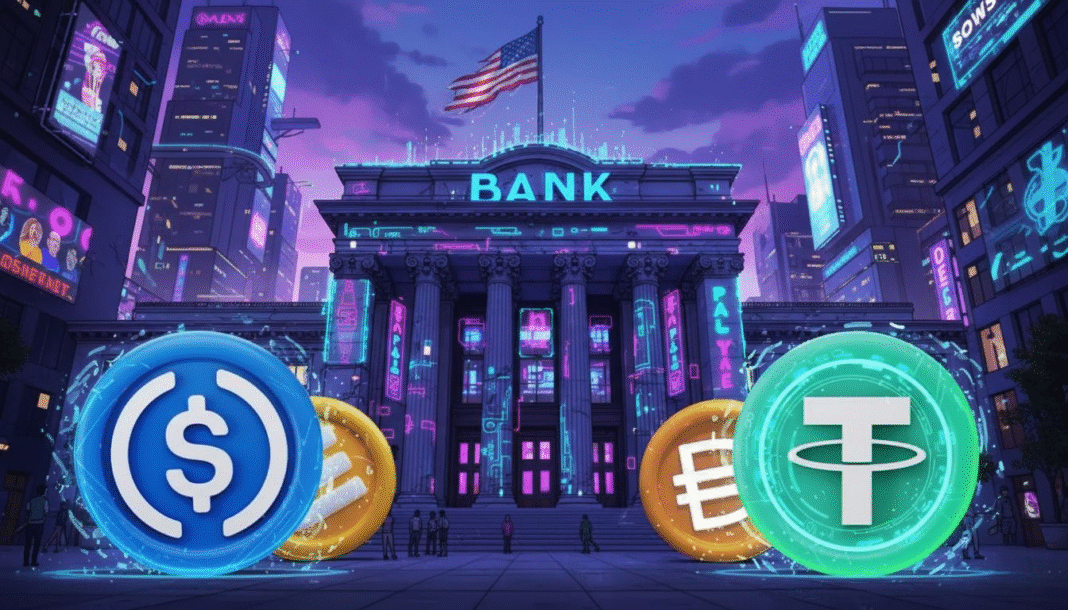Nine major banks from around the world have said they will work together to create a stable cryptocurrency that will use the currencies of the G7 countries.
The group includes Goldman Sachs, Deutsche Bank, Bank of America, Banco Santander, BNP Paribas, Citigroup, MUFG Bank, TD Bank Group, and UBS, based on a Bloomberg report released on Friday.
Banks said they will look into creating a digital payment asset that is backed by reserves and can be used on public blockchains. Each unit of this asset will be worth the same as regular money.
The coalition has stated that it is in touch with regulators and supervisors in important markets to see if the initiative could improve competition in digital payments.
Wall Street banks come together to create a stablecoin that competes with Tether and Circle.
Banks Aim for $50 Trillion Payment Chance
Old financial companies are speeding up their trials with blockchain technology now that there are clearer rules in the United States and the European Union.
Stablecoins are becoming a quicker and cheaper way to make payments compared to old methods. Bloomberg Intelligence thinks that by 2030, this technology could handle over $50 trillion in payments every year.
The business model has been very profitable for current issuers, allowing them to make a lot of money from the Treasury securities and cash equivalents that support their tokens.
Tether Holdings runs the biggest stablecoin in circulation and makes billions of dollars every year from its reserve assets. Right now, it is trying to raise up to $20 billion in funding, which could make it one of the most valuable private companies in the world.
The banking group is joining after other banks have started their own blockchain payment projects. For example, Bank of New York Mellon is looking into special digital deposits, and JPMorgan recently tested a new token called JPMD that stands for dollar deposits at their bank.
In late September, HSBC started a new service for businesses that lets them safely send money across borders using blockchain technology.
Financial companies see blockchain payment systems as important tools for their plans to turn traditional assets like stocks, bonds, and investment funds into digital versions.
Earlier this year, a few big companies in the U. S Banks like JPMorgan, Bank of America, Citigroup, and Wells Fargo are said to have talked about starting a shared stablecoin project, but these discussions are still just ideas.
Old banks are trying hard to take advantage of the move to digital money
Standard Chartered said this month that stablecoins could take over more than $1 trillion from banks in developing countries by 2028. People in countries with high inflation are starting to use tokens like Tether’s USDT as if they were regular dollar bank accounts.
The threat has led to actions from financial regulators in important locations. At first, British regulators suggested limits on how much money retail customers can own, setting a range between £10,000 and £20,000, to help prevent people from quickly taking their money out.
Recent news has shown that the Bank of England is getting ready to make exceptions to these rules for businesses like crypto exchanges that need a lot of stablecoins for trading and settling transactions.
Recently, Stripe’s CEO Patrick Collison said that stablecoins will make banks give better interest rates on deposits. He pointed out this trend happening in the U. S Savings accounts are currently paying only 0. 40% interest, but banks make $176 billion each year by keeping their extra money with the Federal Reserve.
More companies are joining the race to use digital money, called stablecoins, which goes beyond regular banks. Big tech companies like Apple, Airbnb, Uber, and X are talking about including these stablecoins in their payment systems.
SWIFT, a big bank organization, is starting to test a stablecoin payment system on Ethereum’s Linea Layer 2 network. They are working with more than twelve banks from around the world, such as BNP Paribas and BNY Mellon.
European banks are actively getting involved in a new project. Nine big banks, like ING, UniCredit, and Deutsche Bank, have come together to create a euro stablecoin that follows MiCA rules, which they plan to launch by mid-2026.
A new report from Coinbase says that the stablecoin market might grow to $1. 2 trillion by 2028. The report also argues against the banking industry’s claims that stablecoins could harm traditional finance.
Right now, banks around the world need to make an important decision. They can either team up with well-known stablecoin companies, like Citi’s support for BVNK, create their own digital currencies, or risk losing payment revenue to cryptocurrency companies and big tech firms.


